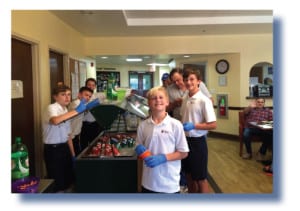By Kathryn Rea Smith, PH.D.
The theme for this month’s edition of Knoxville Parent is “Educating the Whole Child.” Since most parents would like to raise children who are caring and helpful towards the needy, the focus of this article is teaching children to volunteer their time and talent and instilling in them a lifelong desire to help others. I will describe how a group of seventh grade boys is making a difference in our community and learning about the joys of serving others in the process.
Volunteer work that benefits the needy is valuable for all involved. The recipients benefit directly by receiving something they need such as food, medical care, shelter, clothing, counseling, companionship, or comforting. The volunteers benefit in less tangible, but no less important ways. Doing volunteer work provides opportunities for perspective. When working with people who struggle to meet basic needs, one’s own problems appear less dire. And helping to fulfill a genuine need for someone who is less fortunate can be immensely satisfying.
For the past year, my son and his friends have participated in a monthly service project at Samaritan Place, a Catholic Charities’ facility providing emergency, transitional, and long-term supportive housing for very-low income seniors. The boys, all of whom attend Sacred Heart Cathedral School, are encouraged to spend at least four hours per academic quarter doing volunteer work in the community. This project was the brainchild of DeeDee Quinones, mother of one of the boys. DeeDee wanted to arrange an ongoing service opportunity for the boys to obtain their service hours and begin to develop a sense of “social responsibility”. She decided Samaritan Place would be perfect. The Samaritan Place residents would benefit from having regular contact with the polite, friendly, funny, and well-behaved boys, and the boys would benefit from getting to know and serve a group of very special older adults. The boys started the project in sixth grade and now are in the seventh grade. For the monthly projects, they host a two-hour party for the residents, usually centered on a holiday theme (this month they had a Halloween bash). They serve the residents snacks and sodas, then play games like Bingo and hand out prizes and party favors. They also engage in friendly, lighthearted conversation with the residents.
Doing volunteer work provides opportunities for perspective. When working with people who struggle to meet basic needs, one’s own problems appear less dire.
As a parent, the thing I like most about the Samaritan Place project is that the boys are learning to offer the gift of “presence”. They are learning that they can brighten the day of the seniors who live at the shelter through the simple act of spending time with them. The boys are discovering the positive feelings generated from providing service and developing confidence in their ability to do good works. They are increasing their awareness and understanding of situations of those who are more vulnerable than they are.
There are many ways children can be taught to help those who are in need. They learn by observing parents and teachers who donate time, talent, and money, especially when adults talk to them about the personal benefits of doing volunteer work. Children also learn by direct involvement in volunteer activities. For instance, they can collect canned goods for food drives, ask for donations for charity instead of birthday gifts, help out in the church nursery, or participate in school-based, scouts, or youth group mission projects. And although I am not aware of any outcome data regarding individuals who are taught the joys of giving during childhood, it seems intuitive that such children will become adults who are inclined to serve others in the community.
Kathryn Rea Smith, Ph.D. is a private practice psychologist specializing in psychological assessment and parenting consultation. Dr. Smith can be reached at [email protected].
Related posts
Newsletter Subscribe
Newest Posts
Set Up a Parental Control for Online Safety
Have you ever wondered how long your children spend in front of a device without your supervision? Yes, it is…
Adopt A Life, Save A Life
By Jeff Ashin, CEO, Young-Williams Animal Center. Photo by: Young-Williams Animal Center Are you or your child thinking of adding…


